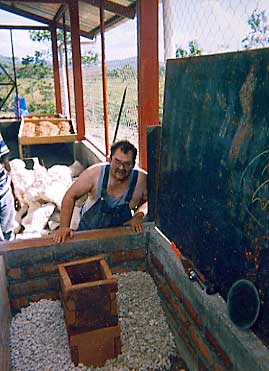
Larry Winiarski's Rocket Stove Principles
Dean Still, April 2002
 |
Dear Friends,
I was typing up Larry's latest simple stove principles for Aprovecho's
newsletter, "News From Aprovecho", (two to three times a year, $30/year,
describes activity, I'm editing number 59) and thought I'd send it along.
Reflecting on the Rocket I might point out a interesting point: no secondary
air. I've tried adding heated secondary air into the top end of the internal
chimney above the combustion chamber but haven't noticed an improvement in
amount of smoke or in fuel efficiency. I ended up thinking that enough
primary air is left at the top of the combustion zone anyway. Adding air may
just reduce temperatures. I'll test this further with better equipment.
The Rocket stove is trying to create supportive conditions for complete
initial combustion which seems to pretty much work when the right amount of
fuel is introduced. The added draft created by the insulated chimney above
the fire pulls in lots of air, which like a fan, makes a hotter, vigorous
burn.
Anyway, here are Larry's principles of stove design:
Best,
Dean
Rocket Stove Principles
Dr. Larry Winiarski
Technical Director
Aprovecho Research Center
Apro@efn.org
1.) Insulate, particularly the combustion chamber, with low mass, heat
resistant materials in order to keep the fire as hot as possible and not to
heat the higher mass of the stove body.
2.) Within the stove body, above the combustion chamber, use an insulated,
upright chimney of a height that is about two or three times the diameter
before extracting heat to any surface (griddle, pots, etc.).
3.) Heat only the fuel that is burning (and not too much). Burn the tips of
sticks as they enter the combustion chamber, for example. The object is NOT
to produce more gasses or charcoal than can be cleanly burned at the power
level desired.
4.) Maintain a good air velocity through the fuel. The primary Rocket stove
principle and feature is using a hot, insulated, vertical chimney within the
stove body that increases draft.
5.) Do not allow too much or too little air to enter the combustion chamber.
We strive to have stoichiometric (chemically ideal) combustion: in practice
there should be the minimum excess of air supporting clean burning.
6.) The cross sectional area (perpendicular to the flow) of the combustion
chamber should be sized within the range of power level of the stove.
Experience has shown that roughly twenty-five square inches will suffice for
home use (four inches in diameter or five inches square). Commercial size is
larger and depends on usage.
7.) Elevate the fuel and distribute airflow around the fuel surfaces. When
burning sticks of wood, it is best to have several sticks close together,
not touching, leaving air spaces between them. Particle fuels should be
arranged on a grate.
8.) Arrange the fuel so that air largely flows through the glowing coals.
Too much air passing above the coals cools the flames and condenses oil
vapors.
9.) Throughout the stove, any place where hot gases flow, insulate from the
higher mass of the stove body, only exposing pots, etc. to direct heat.
10.) Transfer the heat efficiently by making the gaps as narrow as possible
between the insulation covering the stove body and surfaces to be heated but
do this without choking the fire. Estimate the size of the gap by keeping
the cross sectional area of the flow of hot flue gases constant. EXCEPTION:
When using a external chimney or fan the gaps can be substantially reduced
as long as adequate space has been left at the top of the internal short
chimney for the gasses to turn smoothly and distribute evenly. This is
tapering of the manifold. In a common domestic griddle stove with external
chimney, the gap under the griddle can be reduced to about one half inch for
optimum heat transfer.